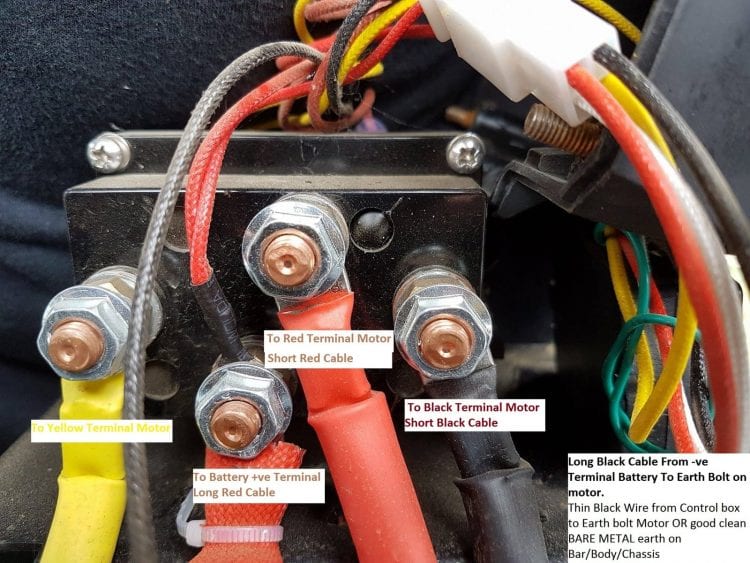Winches are useful during emergencies, like when your car is stuck or helping out another stuck vehicle. It is thus essential to know how to wire a winch without a solenoid. The winch solenoid is the wire coil that features in electromagnetic-operated winches. There are situations where wiring a winch without a solenoid may be necessary.
Like when you notice contaminated or dirty gases, which signals an overload. Other situations where you may avoid a solenoid are where you notice overheating, since the wiring may produce a lot of heat at times.
It’s always wise to run your winch through a solenoid. It is safer for you and the winch that way. Only bypass the solenoid for a moment or if you have no option. You can get replacement winch solenoids here.
Hard Wiring Your Winch Without a Solenoid
For this procedure, you will need the following items:
- Pliers or spanner
- Jumper cables
- A winch solenoid diagram for your specific winch
Then follow these steps:
-
Have a clear representation of the solenoid.
A winch solenoid diagram can help you out in this stage, showing you the design of the motor. You can get the pictorial representation from the manufacturer or from other mechanics with experience in your type of winch.

-
Put the winch in free spool mode.
It is like having your car in neutral gear. You do this by turning a knob, which will make the system easy to move. Before engaging the free spool mode, make sure the winch doesn’t have a load to avoid any accident.
-
Disconnect the terminals from the battery, starting with the positive lead.
Use your pair of pliers or spanner to disconnect the terminals, starting with the positive lead. However, you should leave the grounded lead engaged. Label the cables using the diagram to avoid confusion that may give you false results. Label the three posts near the motor A, F1, and F2.
-
Connect the jumper wire.
Run the cable from point A to F1 and connect it to the battery through F2. The winch motor should run in one direction once you finish this connection.
-
Repeat the procedure with other post
Repeat step 4 with the A and F2 posts and connect it to the power source using the F1 post. The motor should run on the opposite side on completing the connection.
These are the steps to follow when troubleshooting a damaged winch solenoid to determine if you need a winch solenoid replacement. If the motor works well in both directions, then the problem isn’t the solenoid. The issues might lie within the switch.
How to Bypass a Winch Solenoid
If you notice the solenoid system is malfunctioning or to troubleshoot the winch engine, bypassing a winch solenoid is essential. It helps you understand where the issue is in the winch system.
Do the following to bypass a winch solenoid:
- First have a clear impression of the solenoid system to map its terminals and know which to bypass.
- Connect a jumper cable to terminal A, and either F1 and F2 interchangeably using a power source, which is the battery in this case.
- The engine should move in all directions once you connect the jumper cable to the terminals.
How to Wire a Winch Switch
To wire a winch switch you need to fasten the wires from the on/off switch or remote for the winch to the correctly labeled terminals on the solenoid. These wires are typically color-coded to match the solenoid terminals. If they are not, you need to trace them back to their source to determine their polarity. Then make the connections to the solenoid based on this information,
What does a solenoid do in a winch?
Solenoids are electromagnetic switches. The winch solenoid is used to activate the winch motor on a vehicle-mounted winch. It is designed to supply the required current without damaging the winch motor or the winch switch.
It is activated when the current from the winching battery is directed to the solenoid by pressing the activation switch. The winch solenoid’s activation sends current to the motor, then the winch motor starts to run the winch drum.
The main purpose of a winch solenoid is to ease the tension on the winch switch and prevent it from burning up. The solenoid is thus very important to the winch motor.
Do you need a solenoid on a winch?
Yes, you need a solenoid on a winch to help protect the winch motor, especially going by the fact that replacing a solenoid is cheaper than having to replace the motor. But, you can also do without the solenoid, though you need extra caution to avoid secondary issues developing with the winch system of your vehicle.
When replacing solenoids, it advisable you replace them in pairs in most instances where one is faulty, the other one is not far away from failing. You can keep the previous one still functioning as a spare. Make sure you take caution when replacing components on a vehicle. Disconnect the battery before you remove the solenoid covering to avoid getting an electric shock.
